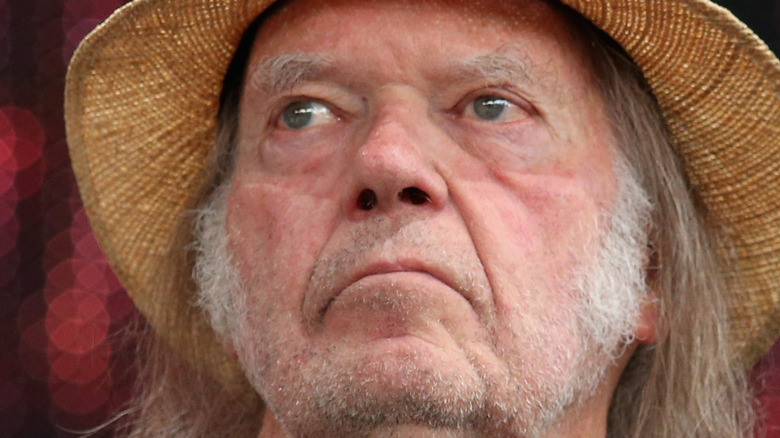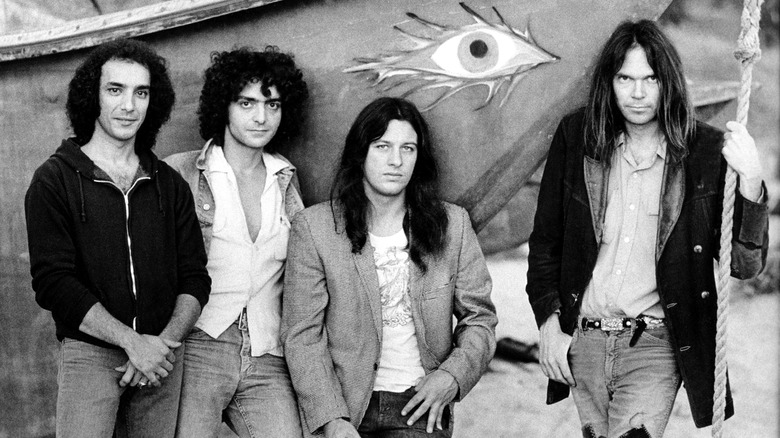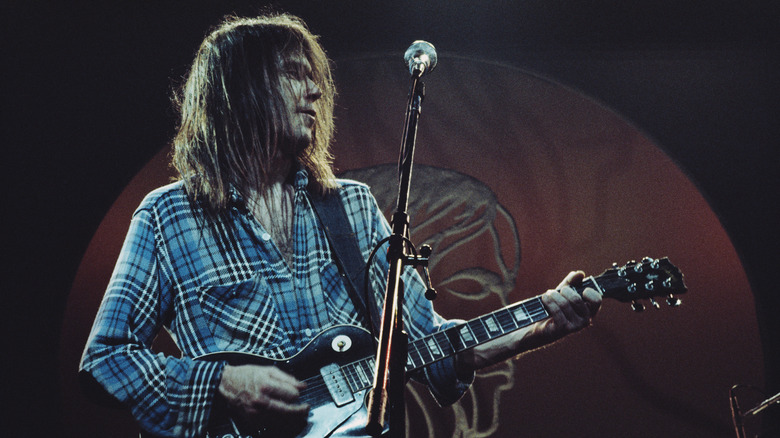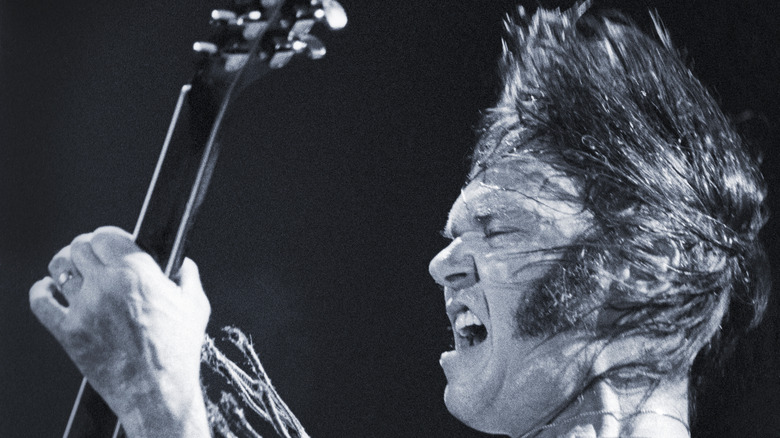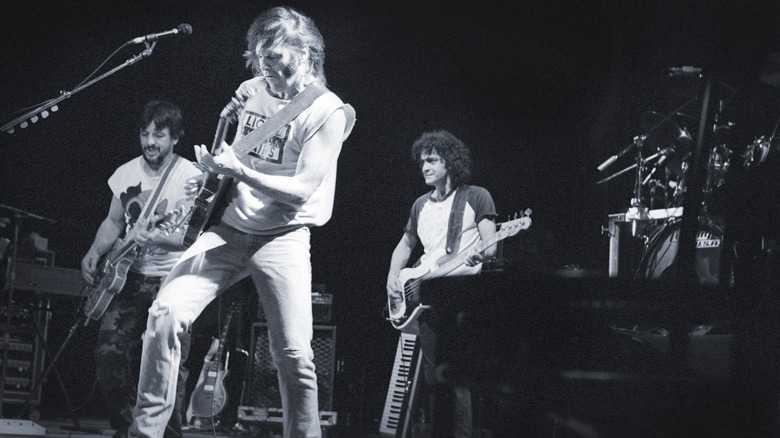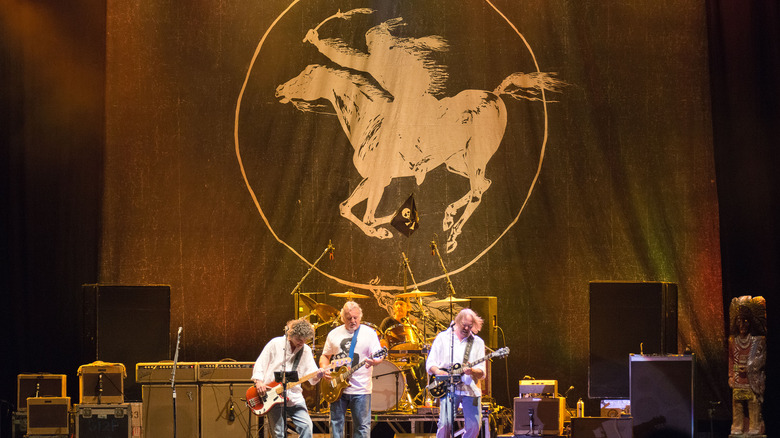Neil Young Wrote Three Classic Songs In One Day While He Had A Raging Fever
Few musicians live and breathe authenticity like Neil Young. As a founding member of Buffalo Springfield in the mid-1960s, an on-again, off-again member of Crosby, Stills & Nash from the late '60s, and a solo musician with over 28 million records sold (via Best Selling Albums), Young's no-nonsense, "play with the feeling" (per Ultimate Classic Rock) folk-rock has left a permanent impression on the world of music. He's also a person of implacable principles, as he demonstrated in 2022. Regardless of the financial impact, he straight-up yanked all his music off of Spotify in protest of Joe Rogan spreading COVID-19 disinformation on the platform, as The New York Times explains. Young said he would do it, he did it, and that was that.
It should come as no surprise, then, that if any artist is going to have a homegrown, keyed-in, not-overly-produced approach to writing music, it's Young and his band Crazy Horse. On Ultimate Classic Rock, he says, "A lot of people think we play simple and there is no finesse, but we're not trying to impress anybody." This attitude has allowed their songwriting to come to the forefront, not their egos. Young and Crazy Horse's original lineup — guitarist Danny Whitten, bassist Billy Talbot, and drummer Ralph Molina — captured musical magic from their very first outing together in 1969's stellar "Everyone Knows This Is Nowhere."
Folks might not know, however, that Young had another source of inspiration for the album: a raging, delirium-inducing fever.
Channeling the spirit of Crazy Horse
When Neil Young left Buffalo Springfield in 1968 to musically strike out on his own, few could have expected him to meet with such future success. After all, his 1969 debut solo album, the eponymous "Neil Young," only sold a shockingly low 900 copies, as Best Selling Albums quotes. Compare that with his highest-selling solo album, "Harvest," released only four years later in 1972 and selling 8.5 million copies. Even Young's second album, "Everybody Knows This Is Nowhere," released the same year as his first, went platinum. So what in the world happened between albums one and two? The short answer is: Crazy Horse.
Young had only met Crazy Horse about nine months before "Everybody Knows This Is Nowhere" was released on May 14, 1969, when the band was called the Rockets. After they played at the famous Whiskey a Go-Go bar in Los Angeles in August 1968, Young more or less just approached them and filched them from their gig, as Ultimate Classic Rock describes. And yet, no one had any regrets because they all worked together so well. Crazy Horse added a rough, spontaneous, even garage-band edge to Young's sentimental, sometimes overly-effusive songwriting.
All the magic was there: a new band, a new energy, and a new phase of life. But Young and Crazy Horse needed one more ingredient to push "Everybody Knows This Is Nowhere" into truly numinous territory: Young's deathly fever.
The fever of the musical muse
Few albums have the immediacy and emergent creative qualities of "Everybody Knows This Is Nowhere." Listening to it feels exactly like sitting in a room listening to a bunch of guys jam — in a very polished, expert way — while the recording happens to be turned on. It sounds like the album we have was just one take out of many, and if Neil Young and Crazy Horse had decided to do another run-through, we would have wound up with different canonical versions of songs like "Down by the River," the title track "Everyone Knows This Is Nowhere," "Cinnamon Girl," "Cowgirl in the Sand," and more. And in a sense, this is exactly true.
"Everybody Knows This Is Nowhere" is a testament to the necessity of not overthinking the creative process and just letting it happen. Or, as Young himself said of composing the album (via Far Out Magazine), "Sometimes [when] I get sick, get a fever, it's easy to write ... Everything opens up. You don't have any resistance. You just let things go." Even though Young could have been describing the fever of creative energy, he was also talking about his actual 39.5-degree Celsius fever at the time (about 103 degrees Fahrenheit). Guitar in hand, presumably delirious and sweating up a storm, he drafted three out of the seven tracks off "Everybody Knows This Is Nowhere," not only in a single day but a single afternoon, as Ultimate Classic Rock says.
Lightning in a bottle
Each of the three fever-induced songs that Young wrote for "Everybody Knows This Is Nowhere" is a standout track distinct from the other. Each one crackles with the energy of the moment, draws the listener into that one feverish afternoon when Neil Young wrote the songs, and showcases the collaborative magic between Young and Crazy Horse.
"Cinnamon Girl," the album's opener and Young's personal favorite, is a rocking, bopping jam with some sweet cymbals and four-on-the-floor claps. As Far Out Magazine cites, Young says that he "wrote this for a city girl on peeling pavement coming at me through Phil Ochs' eyes playing finger cymbals. It was hard to explain to my wife."
"Down by the River" is a trance-like, nine-minute track with a simple verse-chorus structure that loops over and over as Young and company solo and riff on top of it. Young wrote and performed the track on one of his favorite guitars, "Old Black," a 1953 Gibson Les Paul he'd purchased for $50 in 1967, as Ultimate Classic Rock says.
"Cowgirl in the Sand," the album's closer, resembles "Down By the River" in being a longer track (10 minutes). It also has a looping structure that allows each band member to take turns playing phrases on top of its basic chord progression. "Cowgirl in the Sand" is full of melancholy and longing, though, while "Down By the River" is more of a joyful folk romp.
Musical collaboration and improv
Even though Neil Young was, and is, the principle songwriter of his band — it's technically a solo project, after all — "Everybody Knows This Is Nowhere" required not only a blistering fever to generate three of the album's tracks but also the interplay between the members of Crazy Horse. Young has never shied away from describing each and every band member's importance, the same as the band members describe both them and Young as a single, cohesive musical unit.
On Ultimate Classic Rock, Young said of the recording of "Everybody Knows This Is Nowhere," "When I played those long guitar solos, it seemed like they weren't all that long, that I was making all these changes, when in reality what was changing was not one thing but the whole band. Danny was the key. A really great second guitar player, the perfect counterpoint to everything else that was happening." For his part, drummer Ralph Molina talked about playing around with the music, adding, removing, and improvising at will. He said, "We don't know the songs; we don't have charts. We just start playing. The magic just seems to happen."
The results speak for themselves. The entire writing and recording process, top to bottom, took just two weeks. "Everybody Knows This Is Nowhere" catapulted Young's solo career and linked him forever with Crazy Horse. And it was all done "with the whiplash logic of a fevered brain," as Rolling Stone puts it.
One member lost, but still rockin' free
Out of all the musicians involved, the final track from "Everybody Knows This Is Nowhere" — "Cowgirl in the Sand" — served to showcase guitarist Danny Whitten. Young gives much of the credit for the song's final form to Whitten, saying on Ultimate Classic Rock, "Billy and Ralph will get into a groove, and everything will be going along, and all of a sudden Danny'll start doing something else. He just led those guys from one groove to another, all within the same groove."
As it turns out, the lightning in a bottle captured on "Everybody Knows This Is Nowhere" really was a once-in-a-lifetime occurrence. Whitten was kicked out of the band for excessive drug use shortly after "Everybody Knows This Is Nowhere" was released, and he died of a heroin overdose in 1972. It took until 1975 for the band to find his replacement in Frank "Poncho" Sampedro, who stayed with Crazy Horse through 2018, as Rolling Stone explains. This means that "Everybody Knows This Is Nowhere" was the only Neil Young album with its unique musical lineup.
Neil Young has gone on to write numerous iconic songs since the '60s, like "Heart of Gold" (1972), "Hey Hey, My My (Out of the Blue)" (1979), "Rockin' in the Free World" (1989), and many more. But as Young said (via Uncut), it was the two weeks of 1969, when Young was struck with a smoldering fever, that let him "be real instead of fabricating something."
